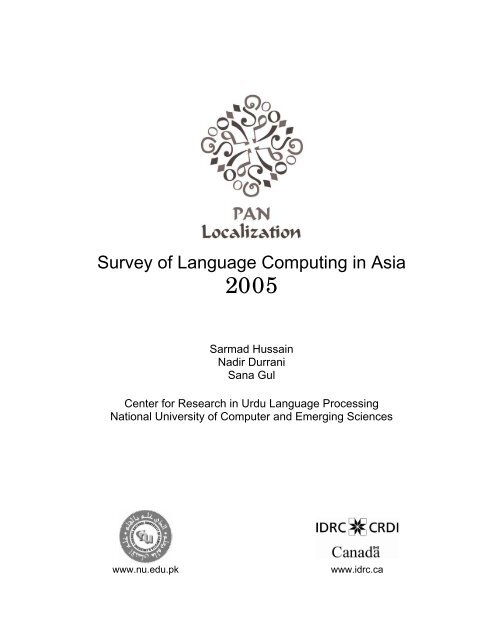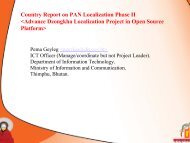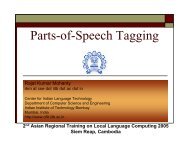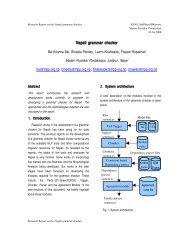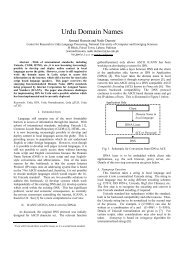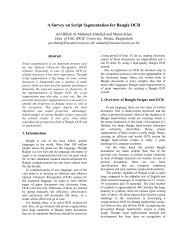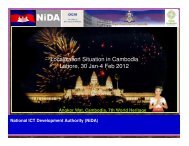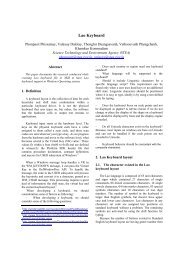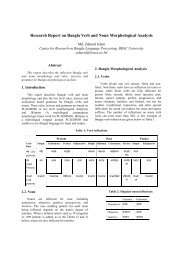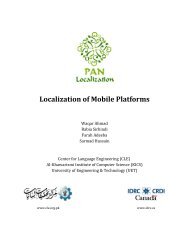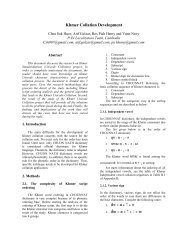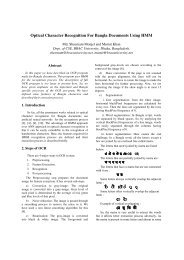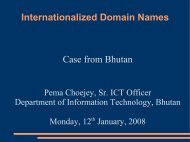Dzongkha - PAN Localization
Dzongkha - PAN Localization
Dzongkha - PAN Localization
You also want an ePaper? Increase the reach of your titles
YUMPU automatically turns print PDFs into web optimized ePapers that Google loves.
Survey of Language Computing in Asia<br />
2005<br />
Sarmad Hussain<br />
Nadir Durrani<br />
Sana Gul<br />
Center for Research in Urdu Language Processing<br />
National University of Computer and Emerging Sciences<br />
www.nu.edu.pk<br />
www.idrc.ca
Published by<br />
Center for Research in Urdu Language Processing<br />
National University of Computer and Emerging Sciences<br />
Lahore, Pakistan<br />
Copyrights © International Development Research Center, Canada<br />
Printed by Walayatsons, Pakistan<br />
ISBN: 969-8961-00-3<br />
This work was carried out with the aid of a grant from the International<br />
Development Research Centre (IDRC), Ottawa, Canada, administered through<br />
the Centre for Research in Urdu Language Processing (CRULP), National<br />
University of Computer and Emerging Sciences (NUCES), Pakistan.<br />
ii
<strong>Dzongkha</strong><br />
<strong>Dzongkha</strong> is a Sino-Tibetan language related to Tibetan. It has 0.13 million first-language<br />
speakers [1] and approximately 0.5 million total speakers [3] in Bhutan. <strong>Dzongkha</strong> is the native<br />
language of eight western districts of Bhutan (Thimphu, Paro, Punakha, Wangdue, Phodrang,<br />
Gasa, Ha, Dhakana, and Chukha) and also recognized as the national and official language of<br />
the country. <strong>Dzongkha</strong> speakers also reside in India (specifically West Bengal) and Nepal [2].<br />
Sino-Tibetan<br />
Tibeto-Burman<br />
Himalayish<br />
Tibeto-Kanauri<br />
Tibetic<br />
Tibetan<br />
Southern<br />
DZONGKHA<br />
Figure 1: Language Family Tree of <strong>Dzongkha</strong> [1]<br />
<strong>Dzongkha</strong> is written in Tibetan script, which was modeled on Devanagari script [3].<br />
Character Set and Encoding<br />
<strong>Dzongkha</strong> character set was not standardized prior to the release of Unicode 4.0. Unicode block<br />
0F00-0FFF is the standard character set encoding used for Tibetan script in computers [4], which<br />
is also accepted as national as well as international standard for encoding <strong>Dzongkha</strong> text [5].<br />
Fonts and Rendering<br />
Tibetan script is complex and not possible to implement using True Type fonts. Open Type fonts<br />
have been developed for Tibetan script for Tibetan and <strong>Dzongkha</strong> by different people and<br />
organizations. These fonts include fonts developed by Department of IT and <strong>Dzongkha</strong><br />
Development Authority in Bhutan, e.g. Tsuyig, Joyig, Tashi, xTashi, Uchen, Wangdi, [5, 6, 7].<br />
Microsoft Platform<br />
Until recently <strong>Dzongkha</strong> was not supported on the Microsoft platform. However, the latest version<br />
of Uniscribe (USP10.dll, version 1.453.3665.0) supports layout tables for Tibetan script. This<br />
version is shipped with Office 2003 Service Pack 1. Inclusion of Tibetan in the latest version of<br />
Uniscribe has facilitated typing and web-browsing in Tibetan script for <strong>Dzongkha</strong>.<br />
Microsoft does not ship fonts for Tibetan script. However, third-party Tibetan script fonts can be<br />
used on Microsoft platform for <strong>Dzongkha</strong> text input and display [6, 8]. Rendering results of some<br />
of these fonts are shown in Figure 2 below.
<strong>PAN</strong> <strong>Localization</strong> Survey of Language Computing in Asia 2005<br />
Figure 2: Unicode <strong>Dzongkha</strong> Fonts on Microsoft Platform [6]<br />
Linux Platform<br />
<strong>Dzongkha</strong> Development Authority, Department of Information Technology and Sherubste College<br />
are working together to enable <strong>Dzongkha</strong> computing on Linux operating system [9, 10] through<br />
the <strong>PAN</strong> <strong>Localization</strong> project [12]. Up till now the project has developed support for inclusion and<br />
rendering of <strong>Dzongkha</strong> Open Type fonts in X-Windows, Red Hat Linux, Fedora Core2 and Open<br />
Office 2.0 (though some technical challenges are still faced). <strong>Dzongkha</strong> Open Type fonts<br />
developed have also been successfully rendered through Pango in GNOME [11].<br />
Keyboard<br />
The Royal Government of Bhutan has nationally standardized a keyboard layout for <strong>Dzongkha</strong>.<br />
This has been designed by the <strong>Dzongkha</strong> Development Authority following consultation with all<br />
the major <strong>Dzongkha</strong> users and the Department of Information Technology. Figure 3 shows the<br />
standard keyboard layout [5].<br />
(a)<br />
48
<strong>Dzongkha</strong><br />
(b)<br />
(c)<br />
(d)<br />
Figure 3: Standardized <strong>Dzongkha</strong> Keyboard in (a) Normal, (b) Shift, (c) Alt+Ctrl and (d) Alt-<br />
Ctrl-Shift States [5]<br />
Microsoft Platform<br />
Based on layout designed jointly by the <strong>Dzongkha</strong> Development Authority (DDA) and Department<br />
of Information Technology (DoIT), Royal Government of Bhutan, Tibetan and Himalayan Digital<br />
Library (THDL) project has created keyboards for <strong>Dzongkha</strong> using MSKLC for Microsoft platform.<br />
It can be used to input <strong>Dzongkha</strong> or Tibetan Unicode text [13, 15].<br />
Linux Platform<br />
Keyboard support for <strong>Dzongkha</strong> on Linux platform has also been developed using the standard<br />
and is being distributed with the Linux distribution being developed by Department of IT through<br />
<strong>PAN</strong> <strong>Localization</strong> project [12].<br />
49
<strong>PAN</strong> <strong>Localization</strong> Survey of Language Computing in Asia 2005<br />
Collation<br />
Collation rules are being finalized through collaboration of <strong>Dzongkha</strong> Development Authority<br />
(DDA) and Department of IT in Bhutan. They are based on the dictionary published by DDA.<br />
Microsoft Platform<br />
Microsoft lists <strong>Dzongkha</strong> in the Sort Options in its latest releases, but the sort is based on<br />
DUCET. Thus, <strong>Dzongkha</strong> sort is not realized. Figure 4 shows the Sort Options on MS Office<br />
2003.<br />
Figure 4: Sort Options for <strong>Dzongkha</strong> on Microsoft Platform<br />
Linux Platform<br />
Collation rules developed by DDA have been implemented on Linux platform. They are<br />
supported in <strong>Dzongkha</strong> version of Open Office 2.0 developed by Department of IT of Government<br />
of Bhutan, through <strong>PAN</strong> <strong>Localization</strong> project [12].<br />
Locale<br />
A nationally standardized locale definition for <strong>Dzongkha</strong> for Bhutan (dz_BT) has been compiled<br />
by <strong>Dzongkha</strong> Development Authority (DDA) in consultation with major computer vendors and<br />
language experts. <strong>Dzongkha</strong> (also known as Bhutani) is now included as a distinct<br />
language/culture within ISO 639, with the language codes "dz" and "dzo" [16]. <strong>Dzongkha</strong> locale<br />
definition has been included in CLDR 1.3 in 2004. The locale definitions described include date,<br />
time, calendar formats, name of days, months and numbers, etc.<br />
Microsoft Windows XP does not include locale definition for <strong>Dzongkha</strong>.<br />
Through the research efforts of Bhutan team of <strong>PAN</strong> <strong>Localization</strong> project, <strong>Dzongkha</strong> locale is now<br />
supported on Linux platform [11]. Locale for GNU C library has been created and implemented in<br />
50
<strong>Dzongkha</strong><br />
Linux operating system. Support for locale and collation rules has also been added to Open<br />
Office 2.0.<br />
Interface Terminology Translation<br />
Microsoft Platform<br />
<strong>Dzongkha</strong> version of Microsoft is currently not available. However development of a localized<br />
version of Windows in <strong>Dzongkha</strong> is on the short term agenda of Microsoft [14].<br />
Linux Platform<br />
Glossary translation of KDE for <strong>Dzongkha</strong> has been initialized but there is still no significant<br />
progress [17]. However, GNOME desktop is complete and work is underway for complete<br />
translation of Open Office through <strong>PAN</strong> <strong>Localization</strong> project [18].<br />
Status of Advanced Applications<br />
There is little progress on the development of advanced applications in <strong>Dzongkha</strong>. Most of the<br />
work under progress is on localization of Linux, specifically GNOME and Open Office platforms.<br />
References<br />
[1] http://www.ethnologue.com/show_language.asp?code=dzo<br />
[2] http://en.wikipedia.org/wiki/<strong>Dzongkha</strong><br />
[3] http://www.omniglot.com/writing/tibetan.htm<br />
[4] http://www.unicode.org/charts/PDF/U0F00.pdf<br />
[5] “Technology Standards and Resources for Computing in <strong>Dzongkha</strong>.” Department of IT, Royal<br />
Govt. of Bhutan. http://www.dit.gov.bt/guidelines/dzongkhastandard.pdf, 2004.<br />
[6] http://salrc.uchicago.edu/resources/fonts/tibetanfonts.html<br />
[7] http://www.dit.gov.bt/downloads/dzongkhafonts.zip<br />
[8] Fynn, C. and Garson, T. “Tibetan fonts." http://iris.lib.virginia.edu/tibet/xml/show.php?xml=/<br />
tools/tibfonts.xml<br />
[9] http://www.iosn.net/country/bhutan/news/dzongkha-on-linux<br />
[10] http://sourceforge.net/projects/dzongkha/<br />
[11] http://dzongkha.sourceforge.net/<br />
[12] www.<strong>PAN</strong>L10n.net<br />
[13] http://iris.lib.virginia.edu/tibet/tools/dzkeyboard.html<br />
[14] http://archives.cnn.com/2002/BUSINESS/asia/08/06/bhutan.windows/<br />
[15] http://iris.lib.virginia.edu/tibet/tools/dzkeylayout.html<br />
[16] “Oficial Nacional Standard of <strong>Dzongkha</strong>-Bhutan Locale.” <strong>Dzongkha</strong> Development Authority.<br />
http://www.dit.gov.bt/guidelines/locale_culture.pdf, 2004.<br />
[17] http://i18n.KDE.org/teams/index.php?a=i&t=dz<br />
[18] http://l10n.openoffice.org/languages.html<br />
51


